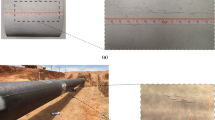Abstract
An unacceptable degree of porosity was identified in several closure welds on stainless steel containers for plutonium-bearing materials. The pores developed in the weld tie-in region due to gas trapped by the weld pool during the closure process. This paper describes the efforts to trace the root cause of the porosity to the geometric conditions of the weld joint and establish corrective actions to minimize such porosity.
Similar content being viewed by others
References
G. Cannell, W. Daugherty, L. Gaston, S. Howard, P. Korinko, D. Maxwell, G. McKinney, C. Sessions, and S. West: “GTA Welding Research and Development for Plutonium Containment,”Proc. 6th Int. Conf. on Trends in Welding Research, April 2002, ASM International.
G.R. Cannell, W.L. Daugherty, and M.W. Stokes: “Welds Safeguard Plutonium-Bearing Containers,”Weld. J., July 2002,81(7).
C.D. Lundin: “Fundamentals of Weld Discontinuities and Their Significance,” Bulletin 295, Weld Research Council, 1984.
Author information
Authors and Affiliations
Rights and permissions
About this article
Cite this article
Daugherty, W.L., Cannell, G.R. Analysis of porosity associated with Hanford 3013 outer container welds. Practical Failure Analysis 3, 56–62 (2003). https://doi.org/10.1007/BF02715934
Received:
Revised:
Issue Date:
DOI: https://doi.org/10.1007/BF02715934




